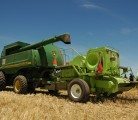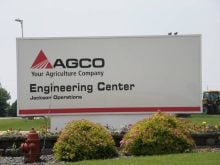Portable mill attached to combine | The Australian machine smashes seeds collected in the chaff
Australian growers have “whole heartedly” embraced the concept of killing weeds during harvest, said an Australian weed scientist.
“We estimate that 70 percent of (Western Australian) growers are using a harvest weed seed control system,” said Michael Walsh of the University of Western Australia.
“Across the rest of Australia the adoption rates are probably in the order of 20 to 30 percent.”
Walsh, the lead author of a paper on weed seed control published in a recent edition of Weed Technology, said more Western Australian growers are collecting and destroying weed seeds at harvest because of herbicide resistance.
Read Also

New wheat varieties offer Prairie farmers jump in yield
Three experimental wheat varieties developed by Agriculture Canada are showing yield increases of eight to 15 per cent over AAC Brandon wheat in registration trials.
“(The) adoption rates reflect the levels of herbicide resistance in the respective regions,” Walsh said in an email.
“The extent of herbicide resistance is far greater in Western Australia.”
According to Walsh’s paper, Australian growers are using and studying several methods to kill weed seeds during harvest.
Most growers have adopted a system in which a mounted chute on the combine places the chaff and weed residues in a narrow row. Growers then burn the rows.
This has been shown to kill nearly all of the annual ryegrass and wild radish seed in the residue.
Walsh and his colleagues, in collaboration with a Western Australian farmer, have developed a more sophisticated method to eradicate weed seed at harvest.
They have built a machine called the Harrington Seed Destructor. It trails behind the combine and crushes weed seeds within the chaff.
As noted on the Western Australia University website, the Destructor is based on mining technology. A cage mill pulverizes the seeds within the chaff.
“What they’re doing, rather than modifying the combine harvester, they’ve got basically a portable mill behind (the combine) and they’re grinding stuff up,” said Adam Davis, a University of Illinois crop science associate professor and U.S. Department of Agriculture scientist.
Australian data show that the machine demolishes at least 95 percent of the annual ryegrass, wild radish, wild oat and brome grass seed present in the chaff.
De Bruin Engineering is now producing the Harrington Seed Destructor, but it isn’t cheap, costing approximately $240,000 Aus.
Australian farmers might be willing to tow a weed seed mill behind their combine, but Davis said North American farmers aren’t ready for the technology.
“That won’t work here,” he said. “It wouldn’t be adopted.”
Most American growers in the U.S. Midwest manage thousands of acres with little or no help. Davis said they’re not going to combine more slowly to pull a cart or hire someone to empty a trailer of chaff and ground up weed seed.
“They (growers) have just enough labour to scrape by. These guys are flying over their ground when they’re harvesting. They don’t want to slow down.”
Addressing the issue is a new version called the Integrated Weed Destructor. A pair of mills mounted on the combine do the job, taking material from the main sieve.
Davis said Australian farmers and scientists are more interested in weed seed control because they have no choice.
“I think what happened in Australia is that herbicide resistance forced the issue. They ran out of options,” he said. “They realized that herbicide resistant weeds were the ones going to seed at the end of the season, and they had to do something about that.”
Despite his reservations, Davis said there’s no doubt that the Australian approach works.
Walsh’s long-term study has demonstrated that mechanical weed seed collection and destruction at harvest, in combination with herbicide use, can drive weed populations to extremely low levels.
“Targeting of weed seed production to restrict population densities … not only has production benefits but importantly reduces the potential for resistance evolution to our remaining highly valued herbicide resources,” Walsh wrote in his paper.
For example, the scientists studied a field that had 35 annual ryegrass weeds per sq. metre. Annual ryegrass counts dropped to 0.5 plants per sq. metre after 10 years of harvest weed seed control, in combination with herbicides.
In plots treated only with herbicide, the annual ryegrass densities dropped to four plants per sq. metre.
Walsh said it’s uncertain if the Harrington Seed Destructor and other Australian approaches would work on North America weeds.
“This is the big question at the moment. These systems rely on high proportions of weed seed retention at crop maturity (harvest) at a height that allows these seeds to be collected during a commercial harvest operation,” he said.
“We have data that indicates these systems will be effective on palmer amaranth. We intend to conduct more studies in the U.S. over the next couple of years.”
For a current related story – Minimal interest in weed mills in the U.S.

For a related story from 2010 click here.
















